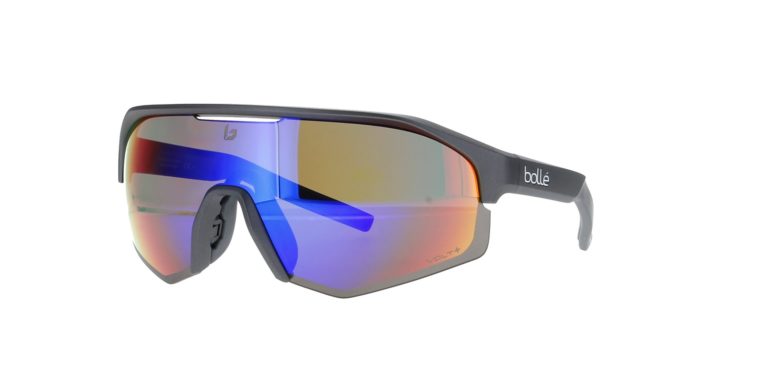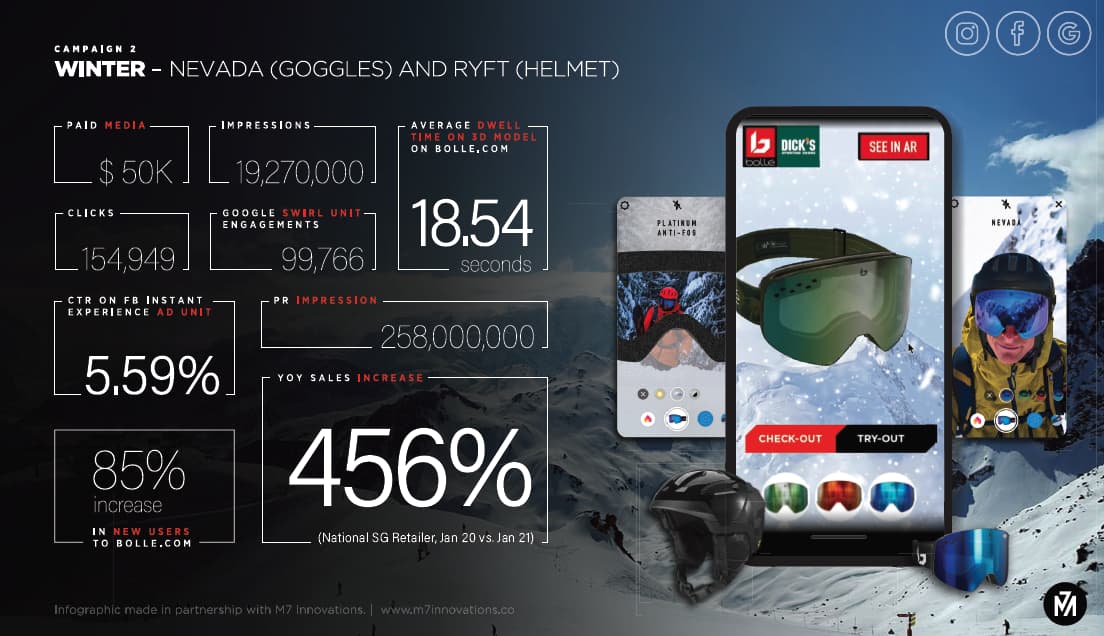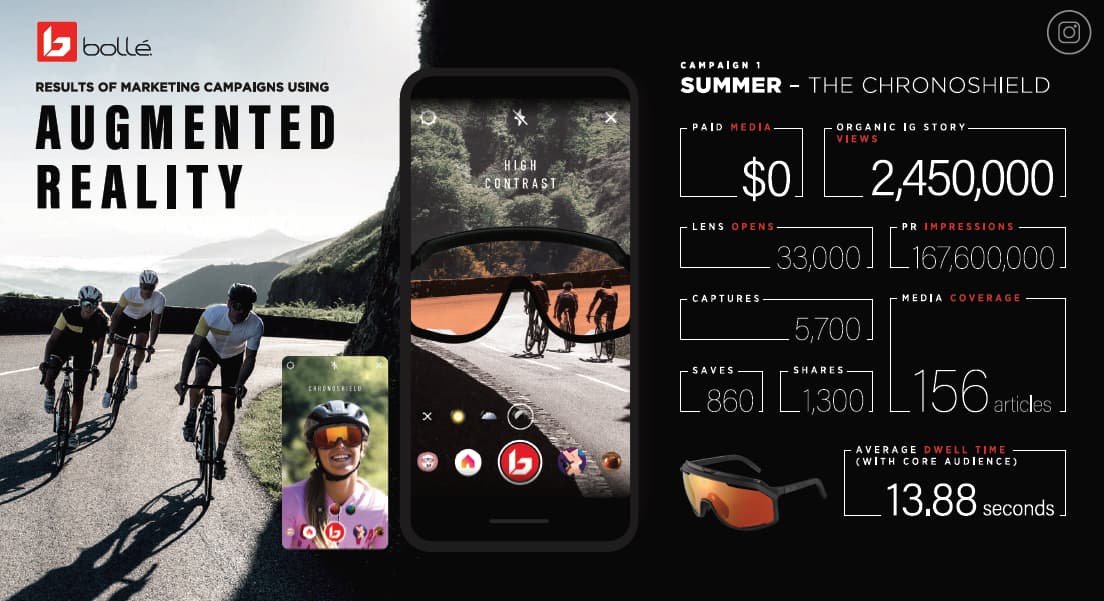
Bollé Brands carries several iconic names in eyewear for lifestyle and sport contexts. These include the flagship Bollé sport brand as well as the youthful Spy brand and the high-end luxury Serengeti label. This lets Bollé cast a wide net for brand persona and addressable market.
Among these personas, its sport brand ethos comes through in its own AR early adoption. Here, AR is a natural fit, Bollé’s VP of Trade Marketing N.A. Chris Abbruzzese tells AR Insider. Its glasses naturally augment reality by adding clarity in low-light conditions in skiing and cycling.
So to emulate this clarifying and high-contrast effect – a big selling point for its glasses – it looked to AR. Working with M7 Innovations and QReal, it engineered an AR experience where users hold up their phones to see the world through Bollé lenses in simulated conditions.
Tactical Competency
This concept was executed in a series of campaigns, each of which gained new insights and tactical competency. For example, in later campaigns, users could make a specific facial gesture (“activation event”) to kick off the experience. This boosts interactivity and engagement.
The activation event is a key tactic according to M7 Innovations founder Matt Maher (see Maher in our ongoing Reality Bytes series). When done right, it can act as an opt-in mechanism that puts the user in the driver seat for a fun, functional, and immersive experience, he says.
As for objectives, Abbruzzese wanted to achieve several things, including brand building and revenue lift. These goals are well-aligned with AR which, as we’ve examined, has the rare ability to span the consumer purchase funnel from branding/awareness to direct response.
In other words, AR can both engage users in novel ways (upper funnel) and qualify buying decisions through 3D visualization (lower funnel). The latter is the holy grail of digital marketing as it not only boosts sales but does so in measurable ways. Bollé has leaned into both.

Results-Oriented
As for results, Bollé hit several marks noted above. Its first campaign (see graphic above) achieved 2.45 million views for its organic (unpaid) Instagram Story. From there, it achieved 33,000 lens opens, 5,700 media captures, 860 saves, and 1,300 shares.
Importantly, we’re talking about quality engagements. AR interaction breeds greater depth than typical banner ads, where brute force and sheer scale are the name of the game. For example, dwell time with these lenses – a key AR metric as we’ve examined – was 13.88 seconds.
There are also second-order effects as AR’s novelty attracts press attention – in this case, 167.6 million PR impressions from 156 articles. The second campaign then doubled down on lessons from the first, including the “activation event” noted above, and Google Swirl distribution.
Results include 19.27M impressions, 155K clicks, and 99.8K Google Swirl engagements. The latter led to greater engagement depth, represented by an average 18.54 second dwell time. Moreover, the campaign drove 85 percent more users on Bolle.com and a 456 percent sales lift.
Finally, its third campaign for Spy similarly achieved lower-funnel activity. This includes 18 million lens interactions in the first 30 days and a 314 percent sales boost. And as icing on the cake, these campaigns in totality won the Digiday Modern Retail Award for Best Use of Technology.

Lessons & Learnings
All the above raises the question of actionable takeaways. What tactical competency have Abbruzzese and Maher practiced, and learned along the way? And do these lessons represent transferrable learnings and best practices? Here are a few key takeaways.
Native Fit: AR was a natural vessel for Bollé’s objective of emulating the high-contrast “augmentation” that its product achieves. The lesson: use AR when it makes sense (it’s not a silver bullet). When it applies, lean into its unique capabilities, such as 3D visualization.
Muscle Memory: tactical competency can be gained over several campaigns. Don’t treat AR as a one-off marketing stunt. Results improve with every campaign, while costs fall as upfront costs (e.g., 3D models, learning curve), are amortized over several cycles.
Range of Motion: When done right, AR can achieve a range of brand objectives. Its immersive qualities have experiential value for brand building, while also qualifying buying decisions for in-market shoppers. Utilize either or both as they fit campaign objectives.
Creative Capacity: The smartphone era advanced ad tech and analytics but at the cost of creative. Marketers have been confined to tiny boxes. AR returns creative capacity to the ad world by offering dimension and elbow room to think and operate outside the box (literally).
Put Your Body into It: AR is coupled with enabling technologies like camera-based computer vision (to scan spaces before overlaying graphics). This can be utilized for additional interactivity, such as Bollé’s “activation-event” facial gestures noted above.

Activation Energy: AR isn’t yet proven enough to get users to work for it. Reduce AR “activation energy” by onboarding users in frictionless ways. This can piggyback on familiar prompts and brand-owned media such as QR codes on packaging or retail signage.
Own the User: One challenge in brand marketing has always been a loss of control in the last mile. After all the dollars spent on brand equity, the consumer touchpoint is an “assisted sale” through underpaid retail associates. AR re-inserts brands at key decision points.
Shopability: In addition to gaining control at the point of sale, the point itself is shifting. Partly Covid-driven, everything is becoming shoppable – from YouTube videos to Instagram Stories. That shoppability trend is on a collision course with AR-assisted commerce. Be there upon impact.
Continuing Education: Bollé is driven to evolve its AR performance, including activation and conversion rates. Be thirsty for knowledge in evolving with AR. The playbook is still being written. Help write it and can gain a knowledge edge for the next era of brand marketing.
“We are all about optimizing and just getting better,” said Abbruzzese. “Even after our seventh campaign, we’re still learning and applying those lessons to deliver an even bigger mind-blowing experience.”





